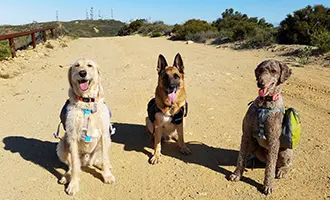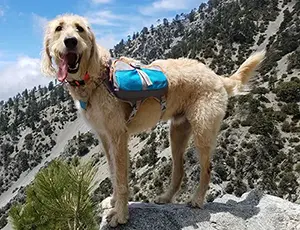
Hiking with dogs is fun! I love hiking and especially enjoy bringing my dogs along. My hikes usually last between four and twelve hours and include significant elevation changes over distance in remote locations.
During my excursions into the wild, I learned much about hiking from an experienced friend, my regular hiking partner. I also made my own observations regarding human and canine needs on the trails.
My regular hiking companion Sylvester, a German Shepherd, is over ten years old but still a very strong hiker. We go on at least one hike per week. Our hikes last four to eight hours, cover a distance of five to ten miles and can include elevation changes of 2000-4000 feet.
Searching the internet, you can find many resources for human hikers, but comprehensive information for canine hiking companions is hard to locate. Most articles seem to center around bringing enough water and taking breaks. These points are, of course, important, but there is much more to consider. Some things are fairly obvious when bringing a dog on a hike, but many are not so straightforward. The goal of this article is to close that gap.
I reference several products I use for my dogs throughout the article. You can find a full product list at the end. Most products include links to Amazon or other online retail stores.
I’m writing this based on my own experiences, but I certainly don’t claim to know everything. I invite other experienced hikers to share their canine hiking suggestions. I’m happy to enhance this article in the future with any valuable information others may have to offer on the subject.
Building Endurance
The first question you should ask yourself is if your dog is suitable to accompany you on the kind of hike you’re planning. Most toy breeds don’t have much stamina and will not be able to endure multiple hours on the trail. In my view, dogs from the sporting group, herding group, and all working dogs are generally best suited for endurance activities. The more energy your dog has, the better it will do on the trail.
However, before a dog can handle longer hikes, it needs to build up its endurance—as we do. I recommend you take your dog on shorter conditioning hikes to build up its endurance. Start with a ninety-minute to two-hour round trip. Once your dog is doing well with that duration, increase by one-hour increments until your dog can handle the type of hiking you’re planning.
The same applies to elevation changes, starting with increases of 1000 feet at first and building up from there. Keep a close eye on your dog to ensure it is adjusting well.
Your dog’s overall condition greatly impacts its ability to perform endurance activities. Veterinarians use a standardized body condition scoring point system to evaluate the overall condition of a dog. A body condition score of five (out of nine) is ideal for most endurance dogs to prevent fatigue and joint-related problems associated with excessive body weight. You can review the most common nine-point scoring system here: World Small Animal Veterinary Association (WSAVA).
Paw Protection
If your dog is new to hiking, pay special attention to its paws. Many people believe that a dog’s paws are virtually indestructible. And while they can certainly withstand a lot, that is unfortunately not the case. Once, I saw a German Shepherd’s paw pads come off during a ninety-minute hike on a dirt road where my other dogs had no problems the week prior. Therefore, I recommend you spend time conditioning and hardening your dog’s paws before you embark on longer hikes in more remote locations.
I have experimented with dog boots to protect my dog’s paws in rougher terrain but couldn’t get them to stay on well. I will probably try again in the future with Ruff Wear Grip Trex Dog Boots. Still, for now, I have switched to using a paw protection cream instead, and I’m happy with that. Musher’s Secret Pet Paw Protection Wax is my favorite so far. I have been applying Musher’s Secret to my dog’s paws before hikes for years, and it provides additional protection.
Backpacks and Carrying Weight

Once your dog has built up some endurance, getting it accustomed to wearing a backpack to carry its food and water is also a good idea. Generally, a dog can safely carry up to 10% of its body weight. You can find references for up to 25% of a dog’s body weight being safe to carry. Still, I recommend keeping it around 10% for harsher terrain and significant elevation changes, so your dog doesn’t get too tired too quickly.
Example: A 60-pound dog can safely carry around six pounds of weight, which can translate to six bottles of water, equaling about three liters. That would be a good amount for a four-to-six-hour hike. More on that later.
Picking the Right Backpack
I recommend getting a good-quality dog backpack to carry the load. You can find decent models on Amazon for around $40. Cheaper ones lack padding and won’t stay in place once your dog starts moving. If you are a frequent hiker, it makes sense to invest in a high-quality dog backpack, just like you invest in a high-quality backpack for yourself. One of the nicer ones I’ve seen is from the Cesar Millan Product Line. It has straps to prevent items from moving around and shifting weight unpredictably, and it has separate compartments for poop bags and other things you may want your dog to carry. This backpack also rests higher up on your dog’s body to avoid putting too much weight on the middle of the spine—a dog is not a horse, which helps protect its back. It costs around $60.
The best one I have is a CaliberDog K9 Tactical MOLLE Vest with two MOLLE bags. It is a harness with bag attachments. This will cost you almost $300, but it is fantastic. Serious hikers will appreciate it.
Similar to human backpacks, proper padding in the right places makes a big difference over longer periods. To prevent your dog from being uncomfortable and getting sore spots, pay special attention to where the straps are touching your dog’s body and if they are protecting its skin sufficiently.
Rattlesnakes

While hiking in nature, you will encounter other animals, some of which can pose a life-threatening danger to you and your dog—rattlesnakes are at the top of that list. Without knowing better, a moving snake is a fascinating animal for a dog to pursue, but that tends to end poorly. I live in Southern California, where we can encounter six different breeds of rattlesnakes. In Northern California, you usually encounter only two different types, and in the rest of the United States usually only one type of rattlesnake. However, when you go to other states like Florida, you will also encounter black mambas and other poisonous snakes that don’t exist anywhere else.
I highly recommend taking your dog to rattlesnake avoidance training before hiking together. During this training, your dog learns to avoid the sight, sound, and smell of rattlesnakes.
Rattlesnake Avoidance Training
It is important to attend rattlesnake avoidance training in the area you’re living in and/or hiking in. That way, you ensure that your dog is trained with the breeds of rattlesnakes you will encounter on the trail. Those will vary by area but, in most cases, will include the Western Diamondback, (North and Southern) Pacific, and Mojave rattlesnakes. This kind of training has the advantage that your dog will also act as a rattlesnake warning system and help keep you safe. Read more at Rattlesnake Season is Here.
Rattlesnake Vaccines
You may have seen rattlesnake vaccines for dogs offered by your veterinarian, but I advise against them. For one, they have a higher risk of serious side effects than other dog vaccinations but even more importantly, do not protect your dog from rattlesnake poison. These vaccinations only give you additional time to get your dog to a veterinarian to administer the anti-venom. However, for the Northern Pacific rattlesnake, they are mostly useless, and for the Southern Pacific rattlesnake totally useless. Read more at Rattlesnake Avoidance Training vs. Rattlesnake Vaccine.
The same rattlesnake vaccine effect can be achieved with Benadryl. In case of a snakebite, give your dog Benadryl. The standard tablets contain 25 mg of Diphenhydramine each, and the number of tablets required depends on body weight. This information can be found on the product packaging and is the same for humans and dogs. For example, if your dog weighs sixty pounds, you would give it the same number of 25 mg tablets as a sixty-pound person. As your dog probably doesn’t swallow pills voluntarily, I recommend you become familiar with how to make a non-cooperative dog swallow a tablet. I also bring a few pill pockets and would try that first.
Benadryl is also advisable as an emergency response to a human rattlesnake bite.
Water
Dogs need constant access to water while they exercise. That is no different when you’re hiking. The longer you hike, the warmer it gets, or the higher you go, the more water your dog needs. A dog needs the same amount of water that a person twice that weight would need during the same hike. I usually bring a Water Rover to easily give my dog water without taking my backpack off each time. In my experience, offering your dog water every 15-20 minutes is best. Studies in sedentary dogs suggest maintenance water requirements are between 0.6 and 1mL/kcal. Working dogs require more water.

Example: An 84-pound dog requires 2592 kcal/day to embark on a 4-hour hike (see Food section for calculation). This means the water requirement is above the sedentary minimum of 0.6mL/kcal * 2592 kcal/day = 1.5L/day. In my experience, doubling this amount is a good approach. In this scenario, I would bring about 3 liters (101.5 fl oz) of water for my dog or six 500mL (16.9 fl oz) bottles.
Dogs Can’t Cool Themselves By Sweating
Dogs only sweat negligibly through their paws. Their main way of regulating their body temperature is through panting, regular consumption of water, moving to the shade, and digging holes to lie down in. If your dog starts pawing the ground, it is time for a break and more water.
Many push themselves and don’t drink water as often as they should because they don’t feel they have to. Early stages of dehydration are easily ignored as they don’t lead to exertion quickly. Dogs are smarter in that regard. They know when it’s time to rest and drink. If your dog starts panting more heavily, give it water. Similarly, give it water if your dog moves from one shady to another. Or, give it water if your dog starts pawing the ground to access cooler soil to lie down in.
The hotter it gets, the more rest stops you need to make and the more water you will have to bring. A good way to plan is to bring twice the amount of water you will need for yourself. If your trail has freshwater sources, you can scale back the water you’re bringing and carry a water pump with a filter instead. That way, you can refill your drinking bladder, and your dog can drink straight from the stream.
Taking Breaks and Eating Soil
If your dog starts digging and licking the soil, it needs more minerals. High-intensity activities require more replenishment than a lazy day. I use dog power bars designed for active dogs to provide extra nutrition and energy on the trail. I find that American Journey Adventure Bars have the right nutrition for hikes. My dog gets a bar whenever I take a break to eat a snack.
I usually take a short (5-minute) snack break every hour when I hike with my dog. When I am by myself, I often take a GU Energy Gel and keep going. You may find that unnecessary with a younger dog, but pay attention to your dog’s behavior. Your furry friend will let you know if it needs a break. Even older dogs like my 10-year-old Sylvester can hike longer and be okay with enough breaks. However, regardless of what your dog indicates, I recommend offering water every twenty minutes, as mentioned above.
American Journey Adventure Bars also have the right protein, fat, and carbohydrate composition for endurance activities. They did their homework when creating this product—more on that below.
Food
When we hike, we require more nutrition to sustain our energy. As we sweat, we need to replenish our electrolytes (sodium, calcium, magnesium, and so on). We also require more carbohydrates, the primary energy source for most people. The need for more nutrition on hikes is no different for our dogs, but the extra nutrition your dog needs is very different from that of a human.
This article section is how this project started, as I wanted to figure out what food to feed Sylvester on the trail. I am providing a lot of detail on the various elements of nutrition but understand if the below has too much detail for some. For this reason, I started with a summary of the food section.
Food Summary: First, use the simple calculation in this section to calculate your dog’s hiking calorie requirement. Next, select a high-quality food (can be different from your regular food) and look for a protein content of around 30% (or more), a fat content of around 20% (or more), and a carbohydrate content below 30% (the lower, the better). I use Orijen Regional Red as my hiking kibble and American Journey Adventure Bars as a dog snack food. Also, consider adding 4.0 g/1000 kcal of omega-3 fatty acids (EPA and DHA) in form of fish oil to your dog’s diet to support joint recovery. I use Nordic Naturals Omega-3 Pet Oil Supplement.
Nutrition for Working and Service Dogs
I derived much of the following information from the research paper Nutrition for Working and Service Dogs by Joseph Wakshlag (DVM Ph.D.) and Justin Shmalberg (DVM), published in Veterinary Clinics of North America: Small Animal Practice, Volume 44, Issue 4, July 2014, Pages 719-740. It can be obtained at ScienceDirect.com. If you want to dive in deeper, I recommend you spend the $36 and obtain a copy.
The energetic potential of a diet is commonly reported in kilocalories (kcal). Metabolizable energy (ME), as reported on pet food labels, refers to the dietary energy remaining after factoring in energy loss in urine, feces, and gases. Current pet food regulations use the modified Atwater factors to estimate food energy which assigns protein and carbohydrate a ME value of 3.5 kcal/g and fat a ME value of 8.5 kcal/g. However, the actual ME is principally determined by dietary fat and a diet’s total dietary fiber content.
Endurance dogs require higher fat diets to fuel mitochondrial biogenesis and enhance oxidative phosphorylation capacity. The National Research Council (NRC) has established dog energy requirements based on available scientific literature. A multiplication factor is applied to the exponential equation for metabolic body weight (MBW: [kg body weight]0.75) to determine the energy expenditure for dogs in different conditions.
The NRC estimates active pet dogs require 130 x MBW kcal/day for energy maintenance requirements. Depending on the activities, this requirement increases further. The additional increase can be as low as 5% – 10% for racing Greyhounds and up to 800% for endurance sled dogs. For 3-4 hours of hiking, a 30% increase is desirable for 8-12 hours of hiking, a 50% increase is desirable.
Example: Calorie requirements for an 84-pound dog on a 4-hour hike
| 84 lb * 0.453592 = 38.10 kg | [conversion to kg] |
| 38.10 kg 0.75 = 15.34 MBW | [metabolic body weight] |
| 15.34 MBW * 130 = 1993.66 kcal/day | [active dog base level] |
| 1993.66 kcal/day *1.3 (30% increase) = 2591.76 kcal/day | [calories on hiking day] |
For dogs, the distance traveled is far more relevant to increased energy consumption than the intensity of the activity.
The following factors increase energy consumption in hiking further:
- Ambient temperature
- Thermal stress (mitigated by panting)
- Variability of the terrain
- Uneven footing
- Load-bearing
- Elevation
When hiking in the mountains, you can assume an additional increased caloric need of 25 – 50% for your dog.
For endurance working dogs, the food composition should be more than 30% protein, more than 20% fat, and restricting carbohydrates to 30% or lower. Fat, however, is the key to sustaining energy during endurance activities. For example, sled dog diets will go as high as 70% fat and almost no carbohydrates. So, keep protein intake around 30% and increase fat and decrease carbohydrates the more extraneous the hike is for your dog.
Protein
Protein requirements are a requirement for essential amino acids in the diet. Endurance dogs should receive about 30% of ME from highly digestible animal-source protein. Soy-based protein is to be avoided.
Carbohydrates
Overall carbohydrate intake for endurance dogs should be kept under 30% of ME. Studies have shown some benefits with post-exercise carbohydrate loading for multi-day activities, but it is generally not recommended.
Electrolytes and Minerals
Minerals can be classified into major minerals and trace minerals. Deficiencies in major minerals can occur when feeding non-traditional diets. All meat or raw feeding without bones can lead to calcium and phosphorus deficiencies. In the case of such diets, it is recommended to add bone or bone meal. However, feeding breed-specific or high-quality commercial diets shouldn’t be an issue. No deficiencies in other major minerals like sodium, potassium, and chloride have ever been reported in working dogs.
The main way your dog cools itself during exercise is through panting. Panting does not lead to a loss of electrolytes like sweating in humans does. Therefore, electrolyte supplementation is neither necessary nor beneficial. In addition, athletic canines have no reported deficiencies in trace minerals like copper, zinc, iron, manganese, iodine, or selenium. As such, supplementation of those is also not necessary.
Vitamins
Vitamins are classified as either fat-soluble or water-soluble and are required for normal energy metabolism. Most pet foods contain these vitamins far above the required minimums, so there is no need for additional supplementation.
Omega-3 Fatty Acids
Significant attention concerning decreasing the clinical signs associated with osteoarthritis, reducing inflammation, supporting joint and muscle recovery after activities, and improving overall well-being in dogs. Omega-3 fatty acids are polyunsaturated fatty acids. All working dogs—but geriatric dogs in particular—benefit from supplementation. EPA and DHA are found in fish oils, and combined EPA and DHA supplementation of roughly 2.5 to 4.0 g/1000 kcal in a diet for older dogs is recommended. One study of a therapeutic joint diet found the greatest benefit in 7.5 g/1000 kcal of EPA and DHA. When supplementing fish oil, keep in mind that this increases caloric intake and adjustments to the base diet are sensible. Fish oil contains about nine calories per gram, and one teaspoon adds approximately 45 calories to the diet. A good product is Nordic Naturals Omega-3 Pet Oil Supplement.
List of References
- PDF: The Canine Body Condition Score (WSAVA)
- Ruff Wear Grip Trex Dog Boots
- Musher’s Secret Pet Paw Protection Wax
- CaliberDog K9 Tactical MOLLE Vest
- MOLLE Bags
- High-Quality Dog Backpacks
- Rattlesnake Avoidance Training
- Benadryl
- Pill Pockets
- American Journey Adventure Bars
- Water Rover
- GU Energy Gel
- Orijen Regional Red
- Nordic Naturals Omega-3 Pet Oil Supplement
- Study: Nutrition for Working and Service Dogs




